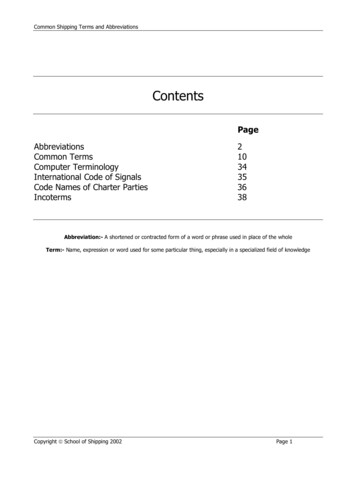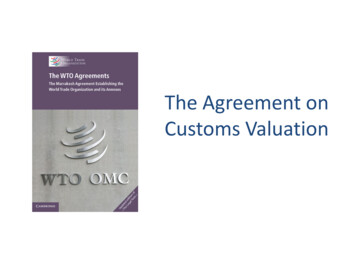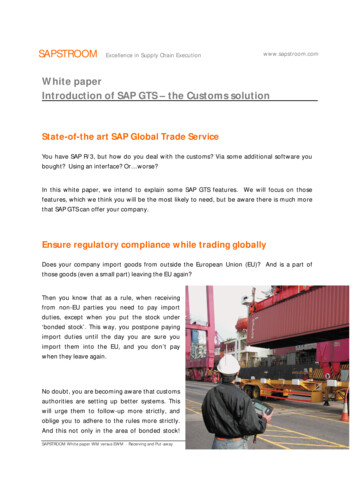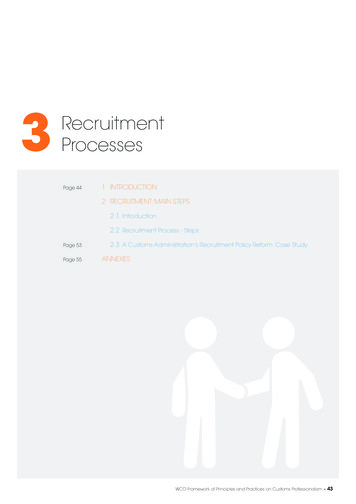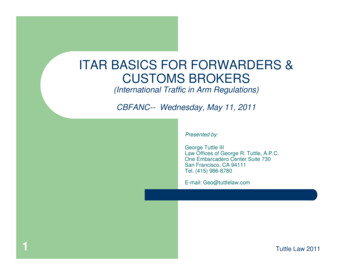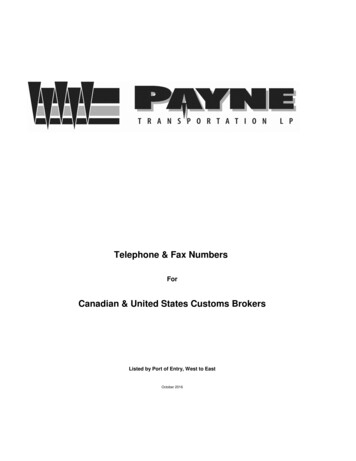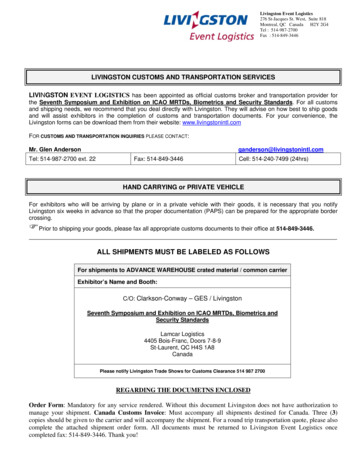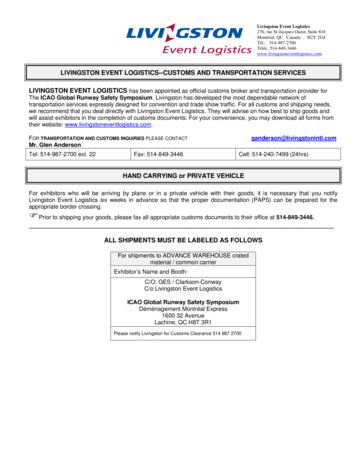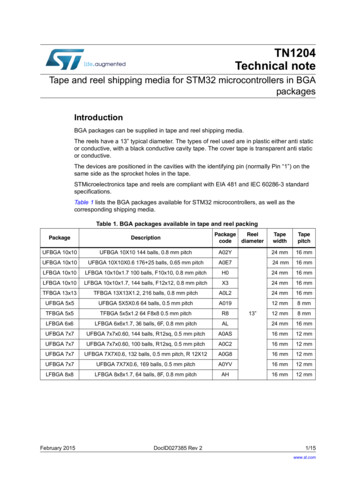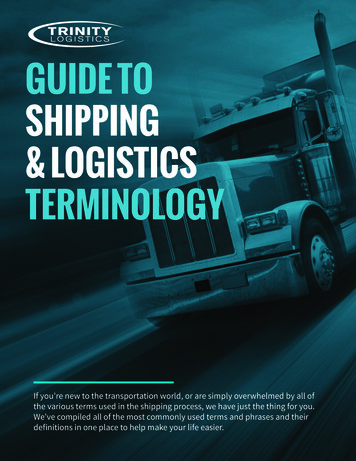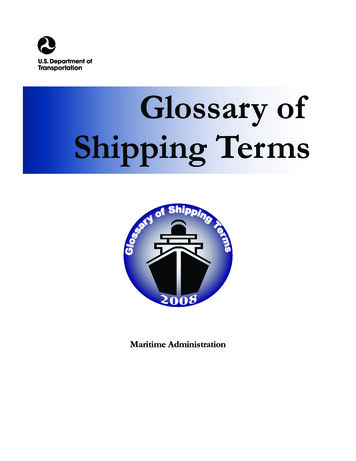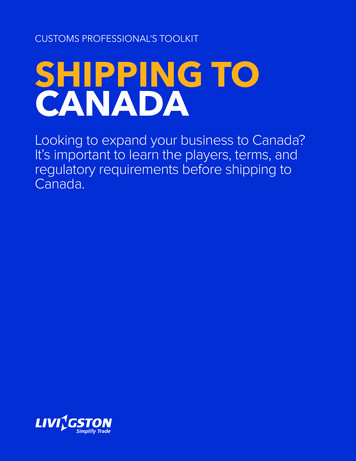
Transcription
CUSTOMS PROFESSIONAL’S TOOLKITSHIPPING TOCANADALooking to expand your business to Canada?It’s important to learn the players, terms, andregulatory requirements before shipping toCanada.
Customs professional’s toolkitShipping to CanadaLooking to expand your businessto Canada? It’s important to learnthe players, terms, and regulatoryrequirements before shipping toCanada.With over 30 million people and active manufacturing, lumber, food and oil and gas sectors, Canada is an attractive market for U.S.companies looking to grow and expand their customer base and their supply chains.But even though these two countries share a long border and enjoy strong relations, as with any market, there are rules andregulations that govern the movement of goods across that border.The Customs Professional’s Toolkit: Shipping to Canada gives you the insight you need to acheive success in Canada.Table of contentsCommon Canadian shipping acronyms. . . . . . . . . . . . . . . . . . . . . . . . . . . . . . . . . . . . . . 3Learn to speak the language when shipping to Canada.Learning the key players . . . . . . . . . . . . . . . . . . . . . . . . . . . . . . . . . . . . . . . . . . . . . . . . . . 7Learn the roles and responsibilities of the key players in the import process.Customs documents simplified. . . . . . . . . . . . . . . . . . . . . . . . . . . . . . . . . . . . . . . . . . . . 10An overview of the documents you need to export your goods to Canada.Preparing your customs documents for shipping . . . . . . . . . . . . . . . . . . . . . . . . . . . . 13A handy checklist of required Customs documents.Nine steps to clearing your goods . . . . . . . . . . . . . . . . . . . . . . . . . . . . . . . . . . . . . . . . . 15Learn the steps your goods go through when being cleared by CBSA.Five questions to ask your carrier. . . . . . . . . . . . . . . . . . . . . . . . . . . . . . . . . . . . . . . . . . 18Ready to ship? Learn the the right questions to ask before you do.Shipping low value goods to Canada. . . . . . . . . . . . . . . . . . . . . . . . . . . . . . . . . . . . . . 20Find out if your goods qualify for Canada’s Low Value Shipment program.
Importing and ExportingCanadianshippingacronyms
Importing and ExportingDefinitions of common Canadianshipping acronymsThe following list will assist you in understanding the meanings of many common shipping acronyms.ACROSS – Accelerated Commercial ReleaseOperating Support SystemA system developed by Canada Customs that allowsshipment release information to be electronicallycommunicated to and from Customs.AMPS – Administrative Monetary Penalty SystemA monetary penalty system that enforces compliance withcustoms legislation.CADEX – Customs Automated Data ExchangeSystemAn electronic data interchange systems offered by theCBSA, allowing importers and brokers to file customsaccounting documents (B3 forms) electronically.CBSA – Canada Border Service AgencyThe agency responsible for providing integrated borderservices that support national security and public safety. TheCBSA manages the flow of people and goods crossing intoand out of Canada.CCD – Cargo Control DocumentAn itemized list of the contents of a shipment (also knownas the manifest) to be shown for customs clearance. Themost commonly used manifest is form A8A.CCI/CI – Canada Customs Invoice orCommercial InvoiceAn invoice prepared by the vendor of the goods which issubmitted to the CBSA for all shipments entering Canada.The CCI/CI helps to determine the classification of goods;the value for duty, tax and duty rate; and tariff treatments.CFIA – Canadian Food Inspection AgencyA government department, or OGD, dedicated tosafeguarding food, animals and plants to enhance thehealth and well-being of Canada’s people, environment andeconomy.CSA – Customs Self AssessmentA program which features streamlined release andaccounting processes for qualified Canadian importers.Introduced by the CBSA, it reduces costs associated withcross-border trading.DAS – Detailed Adjustment StatementA document generated when an importer has correctionsto their original customs entry or when Customs initiatescorrections to an entry classification, valuation, origin, or anyother adjustment.
DFAIT – Department of Foreign Affairs andInternational TradeA government department that promotes Canada as adynamic place in which to invest and do business, andnegotiates and administers trade agreements to assist andgrow Canadian companies on the international stage. Someof DFAIT’s programs include:Duty deferral program – companies defer or are relieved ofthe payment of duties.Duties relief program – companies import goods withouthaving to pay duties and taxes (with the exception of theGST), when the goods are to be exported or incorporatedinto the production of goods to be exported.Drawback program – duties are refunded on importedgoods when the goods have been exported. For moreinformation see memoranda series D7.FAST – Free and Secure TradeA joint program between Canada and the U.S. to enhancesecurity at the border while facilitating the free flow ofidentified low risk shipments.GAA – General Agency AgreementThe written authority of a customs broker to act on behalf ofthe importer in transactional customs business.GST – Goods and Service TaxA federal tax that is paid on most goods and services soldin Canada.HST – Harmonized Sales Tax is the combining of GST andprovincial sales tax (PST). HST is used in Newfoundlandand Labrador, Nova Scotia, and New Brunswick (also to beimplementing in Ontario in 2010).LVS – Low Value ShipmentA shipment that is valued lower than 1,600 CDN.HVS – High Value ShipmentA shipment that is valued at or above 1,600 CDN.MFN – Most Favoured Nation TariffThis tariff treatment is applied to goods where Canada hassigned a general trade agreement with the World TradeOrganization recognizing countries Canada is prepared totrade with unconditionally.NAFTA – North American Free TradeAgreementA trade agreement signed by Canada, the United Statesand Mexico enabling importers to substantially reduce,or even eliminate, duties if their products meet specificeligibility requirements.OGD(s) – Other Government DepartmentsGovernment departments which administer import/exportregulations related to their specific industry. Examplesinclude CFIA, DFAIT, etc.
PARS – Pre-Arrival Review SystemA system developed by Canada Customs that allowsrelease information to be processed before goods arrive atthe border.RMD – Release on MinimumDocumentationA release process that allows importers to obtain releaseof their goods prior to the full payment of their duties andtaxes for a prescribed period of time (5 business days).SIMA – Special Import Measures ActA law protecting Canadian manufacturers and producersfrom two sources of unfair competition: dumped goodsimported into Canada at prices lower than they wouldsell for in their home market or at prices below theirfull cost; and subsidized goods imported into Canadathat have been produced as a result of substantialgovernment subsidies. Such goods imported into Canadaare subject to provisional duties or anti-dumping and/orcountervailing duties.TRQ(s) – Tariff Rate Quota(s)A quota for a volume of imports at a lower tariff rate.After the quota is reached, a higher tariff is applied onadditional imports. The distinction between an absolutequota and a TRQ is that under an absolute quota it islegally impossible to import more than the set quota,whereas under a TRQ, imports can exceed the set quotabut a higher over-quota tariff rate is applied to the excess.VFD – Value For DutyAssessing the value of the duty based on the price paidfor the goods in Canadian dollars.VFT – Value For TaxThe total of the VFD plus applicable duties. GST/HSTtaxes are assessed based on the VFT.Contact Livingston Have questions or need help with your shipments? Contact your account executive, write to us at:simplify@livingstonintl.com or give us a call at 1-800-837-1063www.livingstonintl.com
Importing and ExportingShippingto CanadaLearning thekey playersLearn the roles and responsibilitiesof the key players in the import process
Importing and ExportingShipping to CanadaKey supply chain andplayers’ rolesRoles and responsibilities of players inthe import processWhether you’re new to shipping internationally or aseasoned importer/exporter, if you want to avoid running intoproblems at the border you need to know the key playersin the shipping process and their respective responsibilities.The following is a brief overview of who’s who whenshipping to Canada:The exporterThe exporter – that’s you. Also known as the shipper orthe vendor, the exporter is traditionally responsible forshipping the goods. This includes preparing the requireddocumentation that will be used throughout the shipping andimporting process.The carrierThe carrier is the freight company that transports the goods.They’re responsible for preparing a Cargo Control Document(CCD) – also known as a manifest, waybill or advice note –which is used to report the shipments to the Canada BorderServices provided by customs brokers include the following: Shipment clearance through the CBSA: obtaining,preparing or transmitting the necessary customs releasedocuments or data for the CBSA or Other GovernmentDepartments (OGDs).Services Agency (CBSA). The carrier submits the CCD to the Shipment accounting to the CBSA: calculating and payingcustoms broker, along with the shipping paperwork providedduties and taxes on behalf of the importer as part of a fullby the exporter. In the future, carriers will need to submit thisaccounting package that is submitted to the Canadianinformation electronically to the CBSA.government.The customs brokerCustoms brokers are licensed by the Canadian government Complete shipment management: arranging for thetransportation, customs clearance and local delivery for ashipment (a one stop solution).to carry out customs-related responsibilities on behalf oftheir clients, the importer of record.The importer/importer of recordThe importer of record (your client) is responsible – andthus liable – for the payment of all duties and taxes andaccuracy of the information presented to CBSA. Therefore,Learn who’s responsiblefor what when shipping yourgoods to Canada.it is important to ensure that your processes are compliantwith all government regulations. Compliance can fall bythe wayside due to a lack of time commitment to correctand input precise data and a lack of internal expertise andresources.
Importers are also required to keep a hard or soft copy ofrecords for six years from the end of the calendar year inwhich the goods were imported.Canada Border Services Agency (CBSA)The CBSA is the federal government departmentresponsible for ensuring compliance with Canada’s tax, tradeand border regulations. It is also responsible for making sureThe importer of record (your client)is responsible – and thus liable –for the payment of all dutiesand taxes and accuracy of theinformation presented to CBSA.that all OGD requirements are met before goods are allowedto enter Canada.The CBSA reserves the right to inspect shipments at theimporter’s expense if the inspection involves loading andunloading cargo; if the examination takes place at a locationbesides a designated customs facility; and if it takes placeafter hours. The CBSA may also deny entry of theshipment into Canada, seize the contents, or requestadditional information.If you are found non-compliant the CBSA may levy financialpenalties under the Administrative Monetary PenaltySystem (AMPS).One way to reduce the frequency of inspections is to havea strong record of compliance, and partner with carriers andbrokers who are also committed to compliance.www.livingstonintl.comContact Livingston Have questions or need help with yourshipments? Contact your account executive,write to us at: simplify@livingstonintl.comor give us a call at 1-800-837-1063
Importing and ExportingShipping toCanadaCustomsdocumentssimplifiedAn overview of the documents youneed to export your goods to Canada
Importing and ExportingShipping to CanadaCustoms documentssimplifiedAn overview of the documents youneed to export your goods to CanadaKnowing which Customs documents to include with yourshipment (and how to fill them out) can be tricky. Gettingit wrong can mean lengthy delays at the border and heftyfinancial penalties.Here’s a brief overview of the key documents you need aswell as some additional documents that might be requireddepending on the type of goods you’re shipping.The four documents you must include withevery shipmentCanada Customs Invoice (CCI) or Commercial InvoiceA commercial invoice is the basic document from which thebuyer or importer pays the vendor or exporter. On importshipments the commercial invoice generally serves a dual Net and gross weights (net weight excludes packaging) Unit price of each item (using the currency of settlement)purpose: to enable you, as the exporter, to collect your Extended pricemoney, and to assist the importer in clearing goods. Currency of settlementYou may provide the required information on either a CCIor a commercial invoice as long as all the prescribed dataelements found on the CCI are included. Terms of delivery and terms of payment Date on which goods began continuous journey toCanada Reference numbers (purchaser’s order number)Check that the following required information is included onthe invoice: Vendor/exporter full legal name, address, and country Import license (if applicable) Freight charges/insurance Consignee full name and addressIf your commercial invoice can’t supply the required Detailed description of each item being shippedinformation, you can complete a CCI for you shipments. TheCCI contains all the information fields required by CBSA. Youcan obtain a copy here:Learn about the key customsdocuments and documentdelivery methods required toship goods into Canada.Bill of Lading (BOL)The bill of lading (BOL) is issued to a carrier by you, theexporter, and describes the goods to be shipped. Thecarrier acknowledges their receipt and the BOL states theterms of the contract for their carriage. A copy of the BOLis also forwarded to the importer to arrange for pick-up ofthe goods, and a third copy is kept for the carrier’s records.
list should specify the number and type of units of materialinside each carton or crate in the shipment. As the exporter,you complete the packing list at the time the goods arebeing prepared for shipment. The packing list helps yourcustoms broker gain further information which can helpavoid delays caused by trying to find out details about thecontents of the shipment.Import PermitsImport permits are additional documents that may need tobe completed if your goods fall under certain categories.These are only necessary if your goods fall under CanadianOther Government Department (OGD) regulations on itemsManifest or Cargo Control DocumentA manifest is a list of the contents of the shipment preparedsuch as food, drugs, textiles, etc.by the carrier with information provided by you, the exporter,NAFTA Certificate of Originto be shown to officials for customs clearance. AnotherA North American Free Trade Agreement (NAFTA) Certificatename for the manifest is Cargo Control Document (CCD).of Origin is the document that shows where the goods wereA manifest/CCD has its own identifier called the cargoas NAFTA eligible. To be NAFTA eligible, your goods mustcontrol number. Once submitted and accepted by CBSA, themanifest and cargo control number are monitored by CBSAto ensure the proper clearance and closure of shipment. Themost commonly used manifest is a Highway Form A8A.produced. This is required if your goods have been qualifiedhave been either produced or substantially manufactured ina member country. To prove that your goods are eligible forpreferential tariff treatment, you must produce a country oforigin certificate.A shipper’s export declaration (SED) is required if goods areYou have two options for sending yourdocuments to customs:being exported from the U.S. and are controlled exports. ToManual document deliveryfind out if your goods fall under this classification, you mustExporters can manually complete the documents then printcheck the commerce control list by contacting the bureau ofmultiple copies (one copy for the carrier and one for theExport Administration at the U.S. Department of Commerce.exporter’s records).The SED must be prepared in English, and be typed orElectronic document deliverywritten in a non-erasable medium. The original should beMany customs brokers offer electronic data delivery andsigned (a signature stamp is acceptable) by the exporterstorage services. Moving to an electronic method of delivery(U.S. principal party of interest), or its authorized forwardingis a good way to stay organized and efficient.Shipper’s Export Declaration (SED)or other agent. If you are using an outside agent to preparean SED, you must grant the agent formal power of attorneythrough written authorization.FreshDesigns - Shipping to Canada - Customs Documents Simplified - 2015Documents required in specialcircumstances:Contact Livingston Have questions or need help with yourPacking Listshipments? Contact your account executive,Packing lists are optional and there is no standard formatwrite to us at: simplify@livingstonintl.comfor composing them. The packing list is the detailed list ofor give us a call at 1-800-837-1063contents of the shipment. It includes quantities, items, modelnumbers, dimensions and net gross weights. A packingwww.livingstonintl.com
ShippingPreparingyour customsdocumentsfor shippinginto CanadaExporting to Canada is made easywith this handy checklist of requiredCustoms documents.
ShippingPreparing your customs documents forshipping into CanadaCustoms documents are the set of paperwork required by the Canada Border Services Agency to accurately and completely identifygoods that are being imported. The description, values and quantities you’re shipping will be recorded and reported to Customs.Documents for clearanceIf you’re shipping goods into Canada, the checklist below will help you gather all the right documents that must accompanyeach shipment.Document*Issued byPARS Notification cover sheetExporter/CarrierExporter/VendorCanada Customs Invoicee-Manifest or Cargo Control DepartmentBill of LadingOther Government Departments (OGD) documents, if applicableCertificates of Origin (if goods are qualified)Shipper’s Export Declaration (if goods are deemed as controlled rter/VendorExporter/Vendor*Other documents may be required depending on the nature of the goods imported.Information you’ll need to complete the documentsName of Canadian customs broker, phone and faxConsignee name and address or Importer of Record and address, if different than consigneeDate of direct shipmentSpecification of commodities/description of goods:Product/part number and descriptionWhat material the product is made fromProduct useNumber of packages and weightConditions of sale/terms of payment/currencySelling price – Total price of goods soldDeclared value – Value of goods only, not including packaging, freight or licensing charges Freight charges/insuranceFreight charges/InsuranceClassification number (10-digit) – All goods that enter Canada are categorized according to the Harmonized SystemClassification (HS). Classification determines the rate of duty and any special requirements your product would be subject toupon import. Contact your broker for assistance with the classification of your goods.Restricted merc
wwwlivingstonintlcom Contact Livingston Have questions or need help with your shipments? Contact your account executive, write to us at: simplify@livingstonintl.com or give us a call at 1-800-837-1063 PARS – Pre-Arrival Review System A system developed by Canada Customs that allows r
